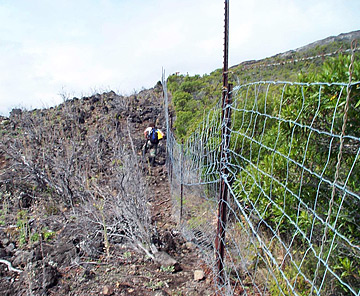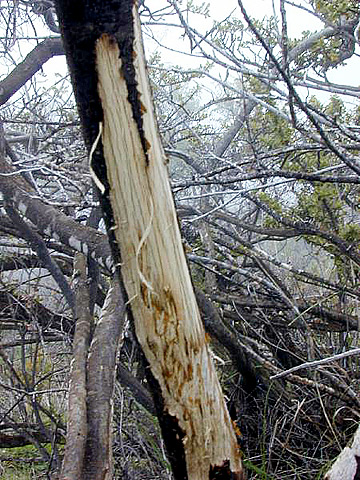
PHOTO COURTESY JACK JEFFREY
Feral pigs are lethal to Hawaiian forests. Their rooting razes away the understory, opening native areas to weeds and increasing erosion on mountain slopes. The animals spread weed seeds far and wide, and their wallows provide habitat for disease-carrying mosquitoes.
|
|
Wildlife in the garden
Pigs and other invasive species are killing native Hawaiian wildlife and costing taxpayers money
By Mary Ikagawa
Special to the Star-Bulletin
IF YOU aren't familiar with the state's game animal overpopulation problem, you might wonder what the fuss is all about. Hawaii has pigs, goats, deer, sheep and even wild cattle running freely over public and private lands. Should we care? What's the big deal?
Game animals like pigs and goats are a recreational resource that also provide food for some people. (I'll eat roast pig any time.) That's the upside. The downside is that these animals are deadly to many of the things we depend on: the watersheds, the water itself (if you like it clean and disease-free), Hawaii's native plants and animals, and the social, cultural and economic benefits that come from a healthy environment and diverse native forests. They also damage people's yards, farms, recreation such as hiking and are a menace on the roads -- particularly deer.
So why aren't the game animals separated from the watersheds and the native forests and people's homes?

COURTESY PATTI WELTON
Forest recovery is occurring above the perimeter fence at Kaupo Gap, Haleakala National Park while goats (and a few cattle, axis deer and pigs) continue to occupy the area below. Goats remove vegetation and reduce the water-holding capacity of soil, increasing erosion.
|
|
ON JULY 19 a meeting in Manoa addressed a special hunting program to reduce the number of pigs in the area. State Sen. Kirk Caldwell opened the proceedings, and staff from the state Department of Land and Natural Resources, Division of Forestry and Wildlife (DLNR/DOFAW), gave a PowerPoint presentation on how the hunt would proceed. Attendees were invited to ask questions by writing them on cards that were read aloud by an aide for DOFAW staff to answer. This might seem like a cumbersome way to conduct a public meeting, but meetings about game animals have gotten heated in the past, and organizers wanted to keep matters civil.
THE GAME animal problems we face now were not created by today's hunters. In the 1989 book "Conservation Biology in Hawaii," Stone and Stone report: "By the late 1800s, foresters and others in Hawaii had become concerned about the destruction of watersheds (areas which contribute to common water collection and runoff downslope) caused by feral ungulates. A program to reduce ungulate populations ... eventually resulted. It included ... creation and fencing of Forest Reserves, removal of animals through hunting, poisoning, and a bounty system. ... This philosophy of ungulate reduction to protect watersheds and soil continued until 1959, when responsibility for feral ungulates was transferred from the Hawaii Department of Agriculture to the Hawaii Department of Land and Natural Resources (DLNR). At this time, hunting seasons and bag limits for ungulates were established and the philosophy become one of sustained yield management (perpetuation of consistent numbers of animals) for hunting, rather than reduction of animals to protect ecosystems and watersheds."
Sportsmen have tried to remake the islands into a mainland-style game range, bringing in fish, game birds, antelope, blacktailed deer and mouflon sheep -- all harmful to the island environment. Modern-day hunting proponents also have introduced earlier arrivals to more islands; the release of axis deer on Maui is one much-regretted example. Good intentions gone awry.
In one sense, it's too bad the animals aren't seen more by us urbanites. Out of sight, out of mind certainly applies here. While we do our living and working among the city streets, everything beyond these streets is being hammered by animals brought from other places. This is not the picture of Hawaii we carry around in our heads, is it?
Watershed health. The heavy rain last winter had a lot of people wondering about the condition of our forests, as huge amounts of soil washed off the mountains, into homes and onto the reef.
Past the edge of town, the problem becomes more visible if you venture past the thick vegetation that lines the roads. Residents and hikers often see pigs and pig damage. Goats, deer and sheep turn the drier areas to wasteland (see accompanying photo). Upslope vegetation loss hurts everything downhill.

COURTESY FOREST AND KIM STARR, USGS
Deer have stripped the bark away from a native mamane tree at Polipoli, Maui.
|
|
Beachgoers might be surprised to learn that "everything downhill" includes the reefs. The Environmental Protection Agency's 2003 Pacific Regional Workshop on Coral Reefs and Land-Based Pollution gives a good example: "Feral goats and axis deer, among other animals, are a major cause of land erosion and sedimentation on Hawaii's reefs. These animals eat plants down to their roots leaving barren lands, which quickly erode. After eradication of feral goats from Kahoolawe, coral reefs were uncovered by wave events, thereby increasing coral recruitment."
Game animals destroy the bottom layer of the forest, the understory. A healthy understory is the first line of defense against erosion. The casual observer might not see how widespread this destruction is because the view is blocked by the tree canopy. Pigs root up the ground in their endless quest for preferred foods and wallows, and goats, deer and sheep gnaw plants down to the roots and strip bark from the trees. Allowing such animals to roam freely throughout the state has been a disaster. Their numbers have been increasing virtually unchecked since active control stopped in 1959, and now the feral chickens are coming home to roost.
The money. An article written a few years ago by UH economics professor James Roumasset titled "Environmental Valuation and the Hawaiian Economy" attempted to put some dollar figures on watershed damage. Just think "astronomical," fellow taxpayers. This article, and many more about feral animal costs, can be found online.
Spending to fight the flood of invasive species coming into Hawaii has risen sharply in recent years as the threat to our quality of life has become obvious. Free-roaming game animals aid and abet many other invasive pests, making everyone's job more difficult and expensive.
More millions are spent annually to protect private property and a small portion of our public natural resources from game animals. Land managers are forced to pick and choose what will be saved, and to come up with funding to make dozens of small fences around the highest-priority resources. Family farms, commercial agriculture and homeowners all suffer damage from free-roaming game animals.
What are we giving up by letting Hawaii's unique character be lost? Travelers can see a goat pasture just about anywhere in the world, but a true Hawaiian rain forest, filled with rare birds and plants, can be seen only here.
Invasive species. This is part of watershed health but deserves its own category. Game animals are a major force in the conversion of our natural areas from diverse forests to expanses of alien plants. By now we're all familiar with invasive species like the coqui frog, miconia and fountain grass. Game animals carry invasive-weed seeds deep into remote areas and help the seeds become established by opening holes in the forest. This is a big deal. It's harder to restore a diverse, healthy forest when there are abundant weed seeds in the soil that will have to be controlled for years.
Invasive species affect everyone. You can read more about this at www.hear.org, the go-to site for invasive-species information in Hawaii.
Disease. The Star-Bulletin reported on April 16, 2004, that Hawaii has the highest incidence of leptospirosis in the United States. This is not an accident -- it's caused by our failure to deal with invasive animals, including pigs and rats.
Diseases and parasites game animals spread in other places include (but are not limited to) encephalitis, foot and mouth disease, swine brucellosis, pseudorabies, bovine tuberculosis and vesicular stomatitis.
Loss of native species. And then there are Hawaii's own rare species, the plants and animals that arrived "by wind, wing and wave" and evolved here over tens of millions of years. Biologists routinely use words like "dazzling" and "astonishing" to describe Hawaii's nature heritage. It is almost incomprehensible that animals like pigs and sheep are being allowed to destroy so many rare native plants and animals, especially since many game animals are in areas that see few or no hunters. Imagine for a moment the frustration and despair of the folks we've hired to protect and restore our watersheds and rare species, as they hike up and find that a population of endangered plants has been eaten by goats, or pigs have moved into a formerly pristine area.
Hawaii has more than 300 endangered species. We look at these numbers and think, "There are so many, we can't do anything about it." But we can and it is straightforward: Grazing animals are a primary threat to most of Hawaii's endangered species. Limiting the range of game animals would be a huge step toward rare species recovery. Again, it's not rocket science; it's just common sense. As one unhappy resource manager put it, you can't keep your livestock next to your garden without a fence!
Game animals destroy native animal habitat, and pig wallows provide perfect conditions for mosquito larvae. Mosquitoes carry the diseases that are killing so many native birds. Feral pigs also eat the eggs of ground-nesting birds and turtles. These destructive animals are every- where, from the beaches to the mountain summits.
Time for action. The U.S. Fish and Wildlife Service has written hundreds of recovery plans for threatened and endangered Hawaiian species that call for removing game animals from the habitat. The state has filing cabinets and hard drives packed with legislation, management plans, maps and partnership agreements all calling for the same thing. Yet implementation remains a fraction of what is needed. Even the Natural Area Reserves have not been adequately protected.
Land degradation by pigs, goats and other grazing animals is a worldwide problem that costs billions of dollars annually in agricultural and environmental damage. The good news is that other places have developed comprehensive control plans that we can borrow from. Hawaii doesn't have to reinvent the wheel, just set it in motion locally and keep it moving. The solution is clear: Hunting over here, healthy forests and watersheds over there.
In 1959 the model changed practically overnight from one of animal control to statewide animal proliferation. Until we change it back again, we will be unable to reverse the accelerating decline in land quality that comes with free-roaming pigs, goats, sheep and deer in an island environment.
Next week: Having it all
ABOUT THE AUTHOR
Mary Ikagawa has a Bachelor of Science degree in botany from the University of Hawaii. After working in the state's endangered-plant protection program, she became concerned about land damage by introduced game animals. Five years ago she started a Web site, www.rarehawaii.org, to raise awareness of Hawaii's game animal problem. She works for the Oahu Invasive Species Committee and is editor of the Conservation Council for Hawaii newsletter.
|

